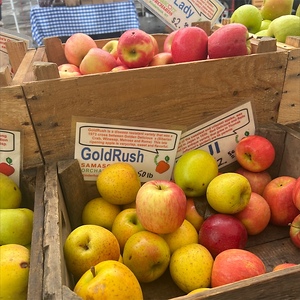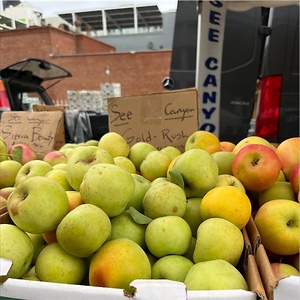


GoldRush Apples
Estimated Inventory, lb : 0
Description/Taste
GoldRush apples are round, ovate, to conical fruits, averaging 6 to 8 centimeters in diameter, and have a somewhat uniform appearance. The semi-thick skin is firm, smooth, slightly waxy, and chewy with a yellow-green base, covered in prominent brown lenticels and light russeting around the stem. The skin ripens to golden yellow in storage, and depending on the level of exposure to sunlight during cultivation, the skin may also bear patches of red-orange blush. Underneath the surface, the fine-grained flesh is dense, pale green to ivory, crisp, and aqueous, encasing a central core filled with black-brown seeds. GoldRush apples are tart when initially harvested, but when kept in storage, the flavor balances, creating a sweet, acidic, and tangy taste.
Seasons/Availability
GoldRush apples are harvested in the fall and can be stored through the spring.
Current Facts
GoldRush apples, botanically classified as Malus domestica, are a late-maturing variety that belongs to the Rosaceae family. The cultivar was created by a cooperative breeding program between Indiana, Illinois, and New Jersey Agricultural Experiment Stations, and the apple was initially created with the intent to develop a highly scab resistant variety. Also known as Co-op38, which is the name used during the research and testing phases, GoldRush apples became highly favored not only for their resistance to disease but also for their balanced, sweet-tart flavor. The apples are known as an all-purpose variety among consumers for both raw and cooked applications, and with prolonged periods of storage, the flavor becomes even sweeter. GoldRush apples were named after their golden coloring and the sensation of an initial flavor “rush” when consumed. Despite their quality taste and vibrant hues, the variety is not commercially cultivated in the modern-day due to the required storage period to develop balanced flavors. GoldRush apples have become a preferred variety grown among apple enthusiasts, and they are also sold as a specialty variety at farmer's markets.
Nutritional Value
GoldRush apples are a good source of potassium, which is an electrolyte that balances fluid levels within the body and contains fiber, which can help regulate digestion. The apples also provide vitamin C to boost the immune system and increase collagen production and contain smaller amounts of iron, calcium, and phosphorus.
Applications
GoldRush apples are best suited for both raw and cooked applications such as baking and stewing. The mild, sweet-tart flavor and crispness of the apple's flesh are showcased when consumed fresh, out-of-hand, and the flesh can be chopped and tossed into salads, sliced and stirred into fruit bowls, thinly sliced and baked as chips, or layered into sandwiches for added crunch. GoldRush apples can also be pressed into juices and ciders, blended into applesauce, baked into crumbles, pies, tarts, cakes, and crisps, minced into sausages, or served with roasted meat and potatoes. GoldRush apples pair well with cheeses such as cheddar, brie, and gruyere, nuts such as pecans, almonds, peanuts, and walnuts, cinnamon, raisins, celery, sweet potatoes, blueberries, and quinoa. The fresh fruits will keep 2-7 months when stored whole and unwashed in the crisper drawer of the refrigerator.
Ethnic/Cultural Info
In the American colonies, hard ciders were one of the most commonly consumed beverages during the 17th and 18th centuries as the fermented drinks were considered safer than water. Many American colonists had their own apple orchard planted beside their house, and with abundant harvests, the colonists processed the excess fruits into cider as a method of preservation. Hard ciders were highly valued in the colonies, and some communities also used the hand-crafted beverage as a form of payment for taxes or job wages. Despite the immediate popularity of hard ciders, production of the drink almost disappeared entirely in the United States during the industrial revolution, as many farmers traded in their country lives for life in urban cities. In the modern-day, hard cider production has seen a revival in the last decade and is one of the fastest-growing liquor segments with many local companies creating unique blends of both modern and heritage apple ciders. There is even a National Apple Cider Day celebrated on November 18th to celebrate and bring awareness to the beverage throughout the United States. GoldRush apples are one of the most popular modern apple varieties used in the production of hard cider. The sweet-tart apples are favored for their balanced, acidic, sweet, and spicy flavors and can create a dry cider with notes of citrus, ginger, and honey.
Geography/History
GoldRush apples were first developed by breeder E.B. Williams and were planted for research purposes at the HE Block at the Purdue Horticulture Farm, located in West Lafayette, Indiana. As the seedling was developed with the golden delicious as one of the main parent varieties, it was believed that there were over six generations of crossings with other cultivars such as the melrose, rome beauty, winesap, and Siberian crab apples. During these generations of crossings, the variety became a product of a joint breeding venture between Illinois, Indiana, and New Jersey Agricultural Experiment Stations. GoldRush was released to the market in 1993 and became the tenth variety developed by the joint breeding program. Today GoldRush apples are grown by select farms as a rare variety and are sold through farmer’s markets and specialty grocers across the United States.
Recipe Ideas
Recipes that include GoldRush Apples. One
| The Recipe Critic |
|
Apple Butter |
| Betty Crocker |
|
Apple Crostata with Caramel Sauce |
| All Recipes |
|
Apple Squares |
| Taste of Home |
|
Apple Pie |
| Delish |
|
Bloomin' Apples |

















